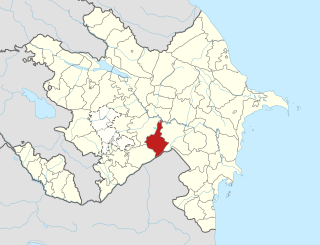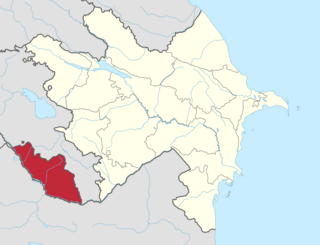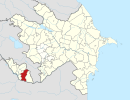
The Nakhchivan Autonomous Republic, is a landlocked exclave of the Republic of Azerbaijan. The region covers 5,502.75 km2 (2,124.62 sq mi) with a population of 459,600 bordered by Armenia to the east and north, Iran to the southwest, and Turkey to the west.

Bilasuvar District is one of the 66 districts of Azerbaijan. It is located in the south-east of the country and belongs to the Shirvan-Salyan Economic Region. The district borders the districts of Imishli, Saatly, Sabirabad, Salyan, Neftchala, Jalilabad, and Ardabil Province of Iran. Its capital and largest city is Bilasuvar. As of 2020, the district had a population of 105,100.

Balakan District is one of the 66 districts of Azerbaijan. It is located in the north of the country and belongs to the Shaki-Zagatala Economic Region. The district borders the district of Zagatala, and the Russian Republic of Dagestan. Its capital and largest city is Balakan. As of 2020, the district had a population of 99,100.

Beylagan District is one of the 66 districts of Azerbaijan. It is located in the centre of the country and belongs to the Central Aran Economic Region. The district borders the districts of Fuzuli, Aghjabadi, Zardab, Imishli, and the Ardabil Province of Iran. Its capital and largest city is Beylagan. As of 2020, the district had a population of 99,500.

Barda District is one of the 66 districts of Azerbaijan. It is located in the center of the country and belongs to the Aran Economic Region. The district borders the districts of Tartar, Agdam, Aghjabadi, Zardab, Agdash, and Yevlakh. Its capital and largest city is Barda. As of 2020, the district had a population of 157,500.

Qabala District is one of the 66 districts of Azerbaijan. It is located in the north of the country and belongs to the Shaki-Zagatala Economic Region. The district borders the districts of Oghuz, Shaki, Agdash, Goychay, Ismayilli, Quba, Qusar, and the Russian Republic of Dagestan. Its capital and largest city is Qabala. As of 2020, the district had a population of 107,800.

Shamakhi District is one of the 66 districts of Azerbaijan. It is located in the east of the country and belongs to the Mountainous Shirvan Economic Region. The district borders the districts of Quba, Khizi, Gobustan, Hajigabul, Agsu, and Ismayilli. Its capital and largest city is Shamakhi. As of 2020, the district had a population of 106,400.

Khizi District is one of the 66 districts of Azerbaijan. It is located in the east of the country and belongs to the Absheron-Khizi Economic Region. The district borders the districts of Siyazan, Shabran, Quba, Shamakhi, Gobustan, and Absheron-Khizi. Its capital and largest city is Khizi. As of 2020, the district had a population of 17,100, making it the least populated district of Azerbaijan.

Sadarak District is one of the 7 districts of the Nakhchivan Autonomous Republic of Azerbaijan. The district borders the district of Sharur, as well as the Iğdır Province of Turkey, Ararat Province of Armenia and the West Azerbaijan Province of Iran. Its capital is Heydarabad and largest settlement is Sadarak. As of 2020, the district had a population of 16,100.

Sharur District is one of the 7 districts of the Nakhchivan Autonomous Republic of Azerbaijan. The district borders the districts of Kangarli, Sadarak, as well as the Vayots Dzor and Ararat provinces of Armenia and the West Azerbaijan Province of Iran. Its capital and largest city is Sharur. As of 2020, the district had a population of 117,600.

Babek District is one of the 7 districts of the Nakhchivan Autonomous Republic of Azerbaijan. The district borders the districts of Julfa, Shahbuz, Kangarli, Nakhchivan city, as well as the Vayots Dzor Province of Armenia and the East Azerbaijan and West Azerbaijan provinces of Iran. Its capital and largest city is Babek. As of 2020, the district had a population of 76,200.

Nakhchivan is the capital of the eponymous Nakhchivan Autonomous Republic of Azerbaijan, located 450 km (280 mi) west of Baku. The municipality of Nakhchivan consists of the city of Nakhchivan, the settlement of Əliabad and the villages of Başbaşı, Bulqan, Haciniyyət, Qaraçuq, Qaraxanbəyli, Tumbul, Qarağalıq, and Daşduz. It is spread over the foothills of Zangezur Mountains, on the right bank of the Nakhchivan River at an altitude of 873 m (2,864 ft) above sea level.

Ordubad District is one of the 7 districts of the Nakhchivan Autonomous Republic of Azerbaijan. The district borders the district of Julfa, as well as the Syunik Province of Armenia and the East Azerbaijan Province of Iran. Its capital and largest city is Ordubad. As of 2020, the district had a population of 50,200.

Shahbuz District is one of the 7 districts of the Nakhchivan Autonomous Republic of Azerbaijan. The district borders the districts of Julfa, Babek, and the Syunik and Vayots Dzor provinces of Armenia. Its capital and largest city is Shahbuz. As of 2020, the district had a population of 25,300.

Kangarli District is one of the 7 districts of the Nakhchivan Autonomous Republic of Azerbaijan. The district borders the districts of Babek, Sharur, Nakhchivan city, as well as the Vayots Dzor Province of Armenia and the West Azerbaijan Province of Iran. Its capital is Givrag, while the largest settlement is Khok. As of 2020, the district had a population of 32,700.

The following outline is provided as an overview of and topical guide to Azerbaijan:
Gülüstan is a village and municipality in the Julfa District of Nakhchivan, Azerbaijan. It is located 5 km in the north-west from the district center, on the right bank of the Aras River.
Mineral waters of Nakhchivan are water springs in Nakhchivan Autonomous Republic that contain various minerals such as, sodium, potassium, magnesium, chloride and sulfur compounds.

The Nakhchivan Autonomous Republic is one of the touristic regions of Azerbaijan with its flora and fauna, climate, and ancient cultural monuments. Nakhchivan is known for its historical monuments such as Momuna Khatun, Yusif ibn Kuseyir, Gulustan tombs, and Garabaghlar. There are other touristic places like Babek castle, Kilit cave, Alinja castle, and Gamigaya in Nakhchivan.

Nakhchivan Economic Region is one of the 14 economic regions of Azerbaijan. It borders Iran to the south, Turkey to the west, and Armenia to the north and east. The region covers the Nakhchivan Autonomous Republic and consists of the districts of Babek, Julfa, Kangarli, Ordubad, Sadarak, Shahbuz, Sharur and the city of Nakhchivan. It has an area of 5,500 square kilometres (2,100 sq mi). Its population was estimated to be at 461.5 thousand people in January 2021.


















